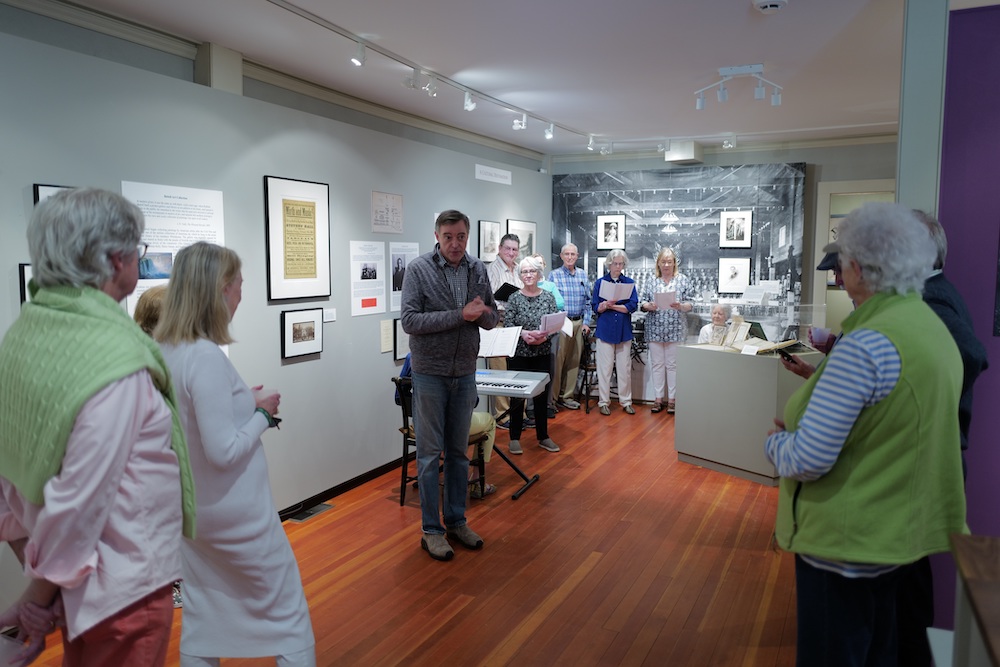Norfolk’s Cultural History
Historical Society’s New Exhibit Traces 200 Years of Art and Music in Norfolk
By Andra Moss
The Norfolk Historical Society opens its 63rd season with an exhibition tracing the origins of organized music and art programs in Norfolk through the many contributions of the Robbins, Battell, Eldridge and Stoeckel families.
“Shedding Light: 200 Years of Art & Music in Norfolk” begins its explorations in 1822, with 11-year-old Irene Battell, daughter of Joseph Battell, at the keys of Norfolk’s first church pipe organ. Her brother, Robbins Battell, equally passionate about music and an accomplished flutist, singer and composer, established the Litchfield County Musical Association to give concerts throughout the region.

It was his daughter, Ellen Battell Stoeckel, whose enthusiasm for hosting evenings of English glee singing at Whitehouse led her to found, in 1898, the Norfolk Glee Club to honor her recently deceased father’s love of choral and sacred music. The following year, also in tribute to her father, she established the Litchfield County Choral Union.
“Ellen was the one with the vision,” says Barry Webber, executive director of the Norfolk Historical Society. “That’s how it all begins—with the glee club.”
By the turn of the new century, hundreds of people across Litchfield County had caught the fever of choral singing. In 1906, the Stoeckels built a concert hall on their Norfolk estate, even expanding the design midconstruction when the chorus swelled to nearly 700 voices. Webber notes with some amazement that “the Music Shed was built for, essentially, an annual weekend festival. This was not a summer-long festival of music; it was just two days.” Thousands attended the Norfolk Festival, and it ran for decades.
The exhibition turns a corner, quite literally, from music to art at a display illuminating the many contributions of the Eldridge sisters, Isabella, Mary and Alice, to the artistic and cultural life of Norfolk. Then, with another shift in (wall) space and time, sepia-toned photographs suddenly give way to an acid green print with the bold header, “Yale at Norfolk Prints 1971.” It is from the portfolio of that year’s artwork by the students and faculty of what was by then the Yale Summer School of Music and Art. The farseeing Ellen Battell Stoeckel had left her Norfolk estate in a private trust with instructions that the facilities be used for this purpose. The first art students came to Norfolk in the summer of 1948.
In 1971, painter and renowned professor of art Robert Reed was the director of the Yale Norfolk art program. Reed had attended the program himself as a student, in 1960, and credited his summer experience as being pivotal to his development as an artist. He would later become the Yale Art School’s first African American tenured faculty member.
The faculty that Reed assembled in summer 1971 included such future art world luminaries as portraitist Chuck Close and photographers Walker Evans and Walter Rosenblum. Listed among the student artists was a young woman from the University of New Mexico, Sue Hettmansperger. Today a professor emerita at the University of Iowa, Hettmansperger still recalls her Norfolk summer vividly.
“Having one of my teachers from UNM pick me was a gift from heaven,” she said in a recent telephone interview. “I was thrown together with some of the very best aspiring artists from all over the country. The ’60s and ’70s were very idealistic, and everyone seemed so interested in reconfiguring the ideas of what it meant to be a person, a woman, an artist.”
The faculty and visiting artists made a lasting impression. Hettmansperger recalled how Close, who had first come to Yale Norfolk as a student in 1961, “showed us a short film that he had done. In it, the camera reads the terrain of the face almost as a topographical map. You could really see what he was reaching for in his art in this little film.”
She also remembers being deeply influenced by Gabor Peterdi, one of the 20th century’s most influential printmakers, and nature photographer Paul Caponigro. “I realized the depth and breadth of what a life in art could be by listening to these artists,” she said.
In addition to the joys of “all day every day, just making art,” Hettmansperger said, “I remember that there were these wonderful chamber music concerts that you could get lost in.” She also recalled sharing a bedroom in a house in downtown Norfolk and that “each person had a small space in the Art Barn to do paintings and drawings. I was next to Sarah Sutro, and I was enamored of her paintings of these little strawberry boxes that were abstract and representational at the same time.”
When pressed for a special memory, she spoke of taking large-format photos of the Norfolk landscape. “I used a 4×5 view camera for landscape photography, and I still have one of a forest floor in Norfolk up on my wall.”
A print by Hettmansperger can be found in the exhibit, once again alongside a Sutro piece of a tiny strawberry basket. Nearby is the group photograph of the 1971 cohort posing, as had become tradition, on the boulders by the Art Barn. Hettmansperger, lower right, is perched beside David Pease, future dean of the Yale School of Art, looking straight into the lens and the new world opening to her.
The Norfolk Historical Museum is located on Village Green and is open weekends, 1 to 4 p.m.
